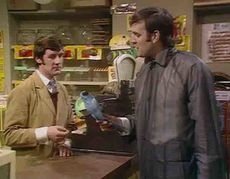Dead Parrot
This refers to an obscure sketch by Monty Python, and/or the inhabitants therein. For all other uses, please find a more relevant article.
Dead Parrots, also known as polygons, are a species of bird found in petshops. The most common subspecies is the Norwegian Blue. They are known for their beautiful plumage, for their lack of activity after prolonged squawk, suspicious stillness, and for being dead.
Description[edit | edit source]
The Dead Parrot is approximately one foot long before stretching, and up to two feet after. It has beautiful plumage, and occasionally a pronounced lump upon its head. The skin beneath the feathers varies in colour, depending on the breed and the stage of decomposition. The Dead Parrot is well-known for being dead.
Subspecies[edit | edit source]
Norwegian Blue, Psittacus mortis caerulus - The most commonly sought after breed of Dead Parrot, the Norwegian Blue is known for its beautiful plumage and for being nailed onto its perch. If not nailed onto its perch, it has a tendency to bend the bars of the cage with its beak and go "Voom, fweeweeweeweewee". It stuns easily, and has a habit of pinin' for the fjords.
Ordinary Dead Parrot, Psittacus mortis mortis - The other main breed of Dead Parrot, the Ordinary ranges in colour from grey to brown to green. It does not pine for the fjords, but otherwise acts much like the Norwegian Blue. It is armed and dangerous.
Conservation[edit | edit source]
The Convention on International Trade in Endangered Species has made the trade of all Dead Parrots a legal muddle. Dead Parrots are often caught by poachers and hunters on unsuccessful journeys to capture living parrots. Illegal trade of Dead Parrots is usually ignored, as it is too much of a hassle to enforce.
Preservation[edit | edit source]
The Dead Parrot does not have a particularly long natural preservation rate. Through unauthorised experiments, an unnamed scientologist has determined that the best ways to keep a Dead Parrot are with formaldehyde, refrigeration, cryogenesis, stuffing, and away from holiday meals.
Mimicry[edit | edit source]
The Dead Parrot is remarkable for being able to mimic still objects. The Norwegian Blue is known to impersonate blue rocks. The Ordinary is known to imitate rocks of many types, including grey, brown, and lichen-covered. The Ordinary has even been seen impersonating small chunks of wood that fell on the forest floor!
Dead Parrots of all types are also known to impersonate resting living parrots. Beware, as the Dead Parrot is armed and dangerous and suspected in at least 34 armed robberies in 11 states.
Breeding[edit | edit source]
Special Parrot mills have sprung up all over the world to breed Dead Parrots. These mills range in location from the Amazon Rainforest to Norway. These breeding mills are not particularly nice places to live, as they are in an industrial atmosphere. As noted in the relevant articles, industries create smog and smog is bad to breathe; therefore, breeding Dead Parrots in an industrial atmosphere is bad.
Mating[edit | edit source]
In order to breed, one must remember that most species, including the Dead Parrot, have to mate. To get the parrot to mate (humanely, or rather, parrotely) requires elaborate setup and a lot of time. First, pick out a very spacious room. Next, paint the room with a non-toxic blue paint and install plenty of fun things for the parrots to do. Get a big feeder with an infinite food supply, as well as an infinite amount of water. Next, put one or more Dead Parrots into the room. After a few days, one will find that there is at least one dead parrot in the room.
Cross-Breeding[edit | edit source]
Cross-breeding is very common with the Dead Parrot. The Dead Parrot is often cross-bred with living parrots, as well. In order to parrotely get these parrots to mate requires at least one dead parrot and two living parrots and the room setup listed above. After waiting several years, one will find the number of dead parrots increases. This number may stop at three, or any number thereafter.
Spontaneous Mutation[edit | edit source]
Sometimes, the Dead Parrot spontaneously appears where a living parrot once was. This is a phenomenon completely misunderstood by scientology. It can take up to twenty years for this to happen. Simply follow the directions for the cross-breeding above, without the Dead Parrot.
Response to electicity[edit | edit source]
Dead parrots in general and the Norwegian blue in particular have an unusual characteristic in that when they have 10,000 volts run through them, something startling happens: nothing at first but then they smoke and burn. Recent studies have found a similar response to electricity in dead Saddam Huessiens.
Natural Behaviour[edit | edit source]
The dead parrot enjoys a variety of activities. These include running down curtains, singing in the choir invisible, and of course kicking buckets.

